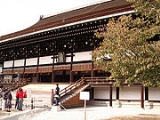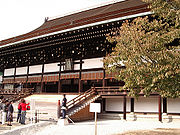
Kamigyo-ku, Kyoto
Encyclopedia

Wards of Kyoto
The city of Kyoto in Kyoto Prefecture, Japan has eleven wards.Unlike the 23 special wards of Tokyo, the wards of Kyoto are not separate municipalities, they are divisions just for municipal administration. Together, they comprise the city of Kyoto, under a single mayor and city council....
in the city
Municipalities of Japan
Japan has three levels of government: national, prefectural, and municipal. The nation is divided into 47 prefectures. Each prefecture consists of numerous municipalities. There are four types of municipalities in Japan: cities, towns, villages and special wards...
of Kyoto, in Kyoto Prefecture
Kyoto Prefecture
is a prefecture of Japan located in the Kansai region of the island of Honshu. The capital is the city of Kyoto.- History :Until the Meiji Restoration, the area of Kyoto prefecture was known as Yamashiro....
, Japan
Japan
Japan is an island nation in East Asia. Located in the Pacific Ocean, it lies to the east of the Sea of Japan, China, North Korea, South Korea and Russia, stretching from the Sea of Okhotsk in the north to the East China Sea and Taiwan in the south...
. Located in the center of the present-day city of Kyoto, Japan it previously occupied the northern region of the ancient capital of Kyoto. The Kamo River flows on the eastern border of the ward. The area was previously a district of residences for the royalty and upper classes in the old capital.
The ward is home to the Kyoto Imperial Palace
Kyoto Gosho
The is an imperial palace of Japan, though the Emperor of Japan is not in residence. The Emperor has resided at the Tokyo Imperial Palace since 1869 and ordered the preservation of the Kyōto Imperial Palace in 1877....
, the Kitano Tenmangu Shinto
Shinto
or Shintoism, also kami-no-michi, is the indigenous spirituality of Japan and the Japanese people. It is a set of practices, to be carried out diligently, to establish a connection between present day Japan and its ancient past. Shinto practices were first recorded and codified in the written...
shrine, the Seimei Shrine
Seimei Shrine
is a Shinto shrine that is located in Kyoto, Japan. It is dedicated to the onmyōji, Abe no Seimei.-History:The Seimei Shrine was founded on the 4th year of the Kankō era by Emperor Ichijō, who ordered the shrine built in memory of Abe no Seimei, after his death in 1005...
, Nishijin-ori textiles, and the headquarters of the Omotesenke
Omotesenke
is the name of one of the three houses or families that count their family founder as Sen Rikyū and are dedicated to carrying forward the Way of Tea that he developed. The other two are Urasenke and Mushakōjisenke. The three are together referred to as the san-Senke...
and Urasenke
Urasenke
is the name of one of the main schools of Japanese tea ceremony. It is one of the san-Senke ; the other two are Omotesenke and Mushakōjisenke....
schools of Japanese tea ceremony
Japanese tea ceremony
The Japanese tea ceremony, also called the Way of Tea, is a Japanese cultural activity involving the ceremonial preparation and presentation of matcha, powdered green tea. In Japanese, it is called . The manner in which it is performed, or the art of its performance, is called...
.
As of the year 2008, Kamigyō-ku had a population of 82,563 people.
- Kamigyo Ward Office Official website(Japanese)
- Kamigyo Ward mascot character, Kamigyukun(Japanese)

